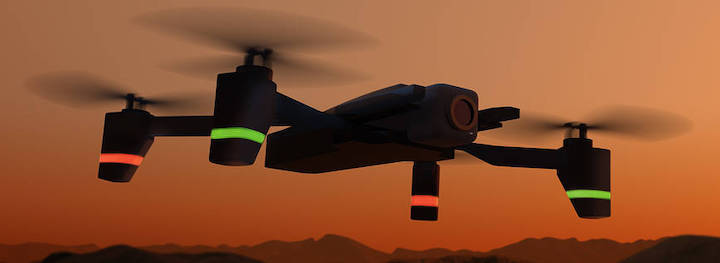18.09.2020
For faster, smarter, safer emergency response operations, the STEReO project is combining NASA technologies and partnerships to build a system that’s greater than the sum of its parts.

When a natural disaster occurs, an impressive number of participants are often needed to help with the response. Consider just the number of different aircraft that might be involved in fighting a wildfire: tankers releasing fire retardant, lead planes to guide them, helicopters dropping off field crews, aircraft from which smokejumpers arrive on the scene… And that’s to say nothing of the activity taking place on the ground. Responding to an emergency like this – or a hurricane or search and rescue effort, to name a few – requires extensive collaboration among a host of groups that, right now, is coordinated manually under challenging conditions. This makes communication difficult.
New technologies have great potential to assist emergency responders, but they also bring new challenges. For instance, unmanned aircraft systems, commonly called UAS or drones, could make firefighters’ interventions faster, more targeted and better able to adapt to changing environments. However, these aircraft also demand special air traffic management, onboard tools to let them operate independently and safely, and expanded communications to keep everyone aware of what’s happening in the sky and on the ground.
Working to tackle these challenges and more is the Scalable Traffic Management for Emergency Response Operations project, or STEReO, led by NASA’s Ames Research Center in California’s Silicon Valley. By building on NASA technologies and expertise and bringing together solutions from multiple agencies involved in disaster response, STEReO aims to make an impact greater than any solution could have on its own. The work, which is a collaboration between Ames and two other NASA centers – Langley Research Center in Hampton, Virginia, and Glenn Research Center in Cleveland, Ohio – is a concept study under NASA’s Convergent Aeronautics Solutions initiative. The results of the CAS study, designed to determine STEReO’s feasibility, will be used to determine whether and how NASA will pursue further development.
STEReO’s Ecosystem for Emergency Response
Illustration of an Unmanned Aircraft System, or drone, in front of a smoke-filled sky. A goal of the Scalable Traffic Management for Emergency Response Operations project, or STEReO, is to make emergency response efforts more targeted and adaptable, for instance by integrating drones into wildfire fighting.
Credits: NASA / Ames Research Center / Daniel Rutter
STEReO envisions a new ecosystem for emergency response that has three broad goals: reduce response times, scale up the role of aircraft and provide operations that can adapt to rapidly changing conditions during a disaster. To demonstrate how its tools and concepts can achieve these goals in different emergency scenarios, STEReO will conduct a live flight demonstration of a wildfire event and a virtual simulation of a hurricane response.
In both cases, they will build on NASA expertise in diverse areas, including air traffic management, human factors research and autonomous technology development. This background, along with input from collaborators – STEReO’s partners range from federal agencies to city and state fire departments, utilities, and private companies – lets the team explore specific concepts like:
- Applying NASA’s Unmanned Aircraft Systems Traffic Management System, or UTM, to public safety uses, coordinating use of the airspace for both crewed and uncrewed aircraft operations
- Collaborative tools to take remote sensing information, such as from sensors on aircraft able to find gas leaks after an earthquake, and distribute a common picture of mission operations
- Communication networks to make the system more resilient to challenging operational environments
- Technologies for more autonomous UAS flight to ensure those operations are both safe and responsive to dynamic situations.
STEReO’s approach will bring increased awareness for all partners responding to an emergency, which could allow for earlier detection of problems and rapid decision making. The full package of STEReO’s emergency response ecosystem could also be scaled to the size and complexity of the specific environment, operations and objectives.
2020 Wildfire Fighting Training
In June 2020, STEReO team members attended a training activity for wildland firefighting, learning firsthand about a key role in this type of disaster response: the air tactical group supervisor, who acts as an airborne air traffic controller for all those planes and helicopters that help fight fires. Hosted by the California Department of Forestry and Fire Protection, this was a significant opportunity for the project to assess the current state of operations and understand components needed for their own flight demonstration. The experience revealed new potential collaborations where NASA know-how in air traffic management, UAS autonomy, UTM, and human factors can help these emergency responders do their jobs more effectively and safely.
Milestones:
- STEReO Stakeholder Workshop (Feb. 11-13, 2020)
- Firefighting field work: Air Tactical Group Supervisor Training (June 2020)
- First airborne assessment of the STEReO project (fall 2020, tentative)
- Wildfire flight demonstration (spring 2021, tentative)
- Simulation of STEReO’s use in hurricane emergency response (fall 2021, tentative)
Collaborators:
NASA’s STEReO team is working with government and industry partners, including the U.S. Forest Service, the Federal Aviation Administration, the California Department of Forestry and Fire Protection, Microsoft, AiRXOS, Inc. and Avision Inc.
STEReO is an execution activity of NASA’s Convergent Aeronautics Solutions project under the Transformative Aeronautics Concepts Program funded through the Aeronautics Research Mission Directorate.
Quelle: NASA
